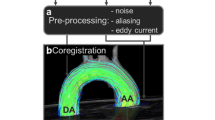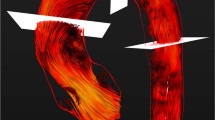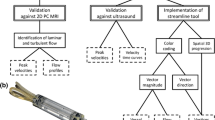Abstract
Three-dimensional velocity-encoded cine magnetic resonance imaging (3D VEC MRI) allows for calculation of secondary flow parameters that may be used to estimate prognosis of individual cardiovascular diseases. However, its accuracy has not been fully investigated yet. The purpose of this study was to validate aortic flow quantification by 3D VEC MRI in vitro and in vivo using stacked two-dimensional acquisitions. Time-resolved stacks of two-dimensional planes with three-directional velocity-encoding (stacked-2D-3dir-MRI) were acquired in an elastic tube phantom with pulsatile flow simulating aortic flow as well as in 11 healthy volunteers (23 ± 2 years). Previously validated two-dimensional through-plane VEC MRI at six equidistant levels in vitro and three locations in vivo (ascending aorta/aortic arch/descending aorta) was used as reference standard. The percentage difference of the stacked-2D-3dir-MRI measurement to the reference standard was defined as the parameter for accuracy. For in vitro aortic flow, stacked-2D-3dir-MRI underestimated average velocity by −6.8% (p < 0.001), overestimated average area by 13.6% (p < 0.001), and underestimated average flow by −7.4% (p < 0.001). Accuracy was significantly higher in the field of view centre compared to off-centre (p = 0.001). In vivo, stacked-2D-3dir-MRI underestimated average velocity (all three locations p < 0.001) and overestimated average area at all three locations (p = n.s./<0.001/<0.001). Average flow was significantly underestimated in the ascending aorta (p = 0.035), but tended to be overestimated in the aortic arch and descending aorta. In conclusion, stacked-2D-3dir-MRI tends to overestimate average aortic area and to underestimate average aortic velocity, resulting in significant underestimation of average flow in the ascending aorta.






Similar content being viewed by others
References
Hope TA, Herfkens RJ (2008) Imaging of the thoracic aorta with time-resolved three-dimensional phase-contrast MRI: a review. Semin Thorac Cardiovasc Surg 20:358–364
Kilner PJ, Yang GZ, Mohiaddin RH, Firmin DN, Longmore DB (1993) Helical and retrograde secondary flow patterns in the aortic arch studied by three-directional magnetic resonance velocity mapping. Circulation 88:2235–2247
von Tengg-Kobligk H, Weber TF, Rengier F, Kotelis D, Geisbüsch P, Böckler D, Schumacher H, Ley S (2008) Imaging modalities for the thoracic aorta. J Cardiovasc Surg (Torino) 49:429–447
Ley-Zaporozhan J, Unterhinninghofen R, Rengier F, Markl M, Eichhorn J, von Tengg-Kobligk H, Ley S (2009) Four-dimensional visualization of thoracic blood flow by magnetic resonance imaging in a patient following correction of transposition of the great arteries (d-TGA) and uncorrected aortic coarctation. Acta Radiol 50:909–913
Hope MD, Meadows AK, Hope TA, Ordovas KG, Saloner D, Reddy GP, Alley MT, Higgins CB (2010) Clinical evaluation of aortic coarctation with 4D flow MR imaging. J Magn Reson Imaging 31:711–718
Bogren HG, Buonocore MH (1999) 4D magnetic resonance velocity mapping of blood flow patterns in the aorta in young vs. elderly normal subjects. J Magn Reson Imaging 10:861–869
Unterhinninghofen R, Ley S, Ley-Zaporozhan J, von Tengg-Kobligk H, Bock M, Kauczor H, Szabó G, Dillmann R (2008) Concepts for visualization of multidirectional phase-contrast MRI of the heart and large thoracic vessels. Acad Radiol 15:361–369
Karmonik C, Bismuth JX, Davies MG, Lumsden AB (2008) Computational hemodynamics in the human aorta: a computational fluid dynamics study of three cases with patient-specific geometries and inflow rates. Technol Health Care 16:343–354
Stalder AF, Russe MF, Frydrychowicz A, Bock J, Hennig J, Markl M (2008) Quantitative 2D and 3D phase contrast MRI: optimized analysis of blood flow and vessel wall parameters. Magn Reson Med 60:1218–1231
Scotti CM, Jimenez J, Muluk SC, Finol EA (2008) Wall stress and flow dynamics in abdominal aortic aneurysms: finite element analysis vs. fluid-structure interaction. Comput Methods Biomech Biomed Eng 11:301–322
Tyszka JM, Laidlaw DH, Asa JW, Silverman JM (2000) Three-dimensional, time-resolved (4D) relative pressure mapping using magnetic resonance imaging. J Magn Reson Imaging 12:321–329
Delles M, Rengier F, Ley S, von Tengg-Kobligk H, Kauczor H, Dillmann R, Unterhinninghofen R (2011) Polynomial regularization for robust MRI-based estimation of blood flow velocities and pressure gradients. Conf Proc IEEE Eng Med Biol Soc 2011:6829–6832
Heiberg E, Ebbers T, Wigstrom L, Karlsson M (2003) Three-dimensional flow characterization using vector pattern matching. IEEE Trans Vis Comput Graph 9:313–319
Rengier F, Delles M, Unterhinninghofen R, Ley S, Partovi S, Dillmann R, Kauczor H, von Tengg-Kobligk H (2011) Impact of an aortic nitinol stent graft on flow measurements by time-resolved three-dimensional velocity-encoded MRI. Acad Radiol. doi:10.1016/j.acra.2011.10.025 [Epub ahead of print]
Bock J, Frydrychowicz A, Lorenz R, Hirtler D, Barker AJ, Johnson KM, Arnold R, Burkhardt H, Hennig J, Markl M (2011) In vivo noninvasive 4D pressure difference mapping in the human aorta: phantom comparison and application in healthy volunteers and patients. Magn Reson Med 66:1079–1088
Frydrychowicz A, Arnold R, Hirtler D, Schlensak C, Stalder AF, Hennig J, Langer M, Markl M (2008) Multidirectional flow analysis by cardiovascular magnetic resonance in aneurysm development following repair of aortic coarctation. J Cardiovasc Magn Reson 10:30
Markl M, Chan FP, Alley MT, Wedding KL, Draney MT, Elkins CJ, Parker DW, Wicker R, Taylor CA, Herfkens RJ, Pelc NJ (2003) Time-resolved three-dimensional phase-contrast MRI. J Magn Reson Imaging 17:499–506
Brix L, Ringgaard S, Rasmusson A, Sørensen TS, Kim WY (2009) Three dimensional three component whole heart cardiovascular magnetic resonance velocity mapping: comparison of flow measurements from 3D and 2D acquisitions. J Cardiovasc Magn Reson 11:3
Nordmeyer S, Riesenkampff E, Crelier G, Khasheei A, Schnackenburg B, Berger F, Kuehne T (2010) Flow-sensitive four-dimensional cine magnetic resonance imaging for offline blood flow quantification in multiple vessels: a validation study. J Magn Reson Imaging 32:677–683
Walsh EG, Holton AD, Brott BC, Venugopalan R, Anayiotos AS (2005) Magnetic resonance phase velocity mapping through NiTi stents in a flow phantom model. J Magn Reson Imaging 21:59–65
Rengier F, Delles M, Weber TF, Böckler D, Ley S, Kauczor H, von Tengg-Kobligk H (2011) In vitro validation of flow measurements in an aortic nitinol stent graft by velocity-encoded MRI. Eur J Radiol 80:163–167
Delles M, Rengier F, von Tengg-Kobligk H, Ley S, Kauczor H, Unterhinninghofen R, Dillmann R (2009) Quadratic phase offset error correction of velocity-encoded magnetic resonance imaging data. Int J Comput Assist Radiol Surg 4:S10–S11
Shrout PE, Fleiss JL (1979) Intraclass correlations: uses in assessing rater reliability. Psychol Bull 86:420–428
Bland JM, Altman DG (1986) Statistical methods for assessing agreement between two methods of clinical measurement. Lancet 1:307–310
Dietrich O, Raya JG, Reeder SB, Reiser MF, Schoenberg SO (2007) Measurement of signal-to-noise ratios in MR images: influence of multichannel coils, parallel imaging, and reconstruction filters. J Magn Reson Imaging 26:375–385
Lotz J, Döker R, Noeske R, Schüttert M, Felix R, Galanski M, Gutberlet M, Meyer GP (2005) In vitro validation of phase-contrast flow measurements at 3 T in comparison to 1.5 T: precision, accuracy, and signal-to-noise ratios. J Magn Reson Imaging 21:604–610
Gatehouse PD, Rolf MP, Graves MJ, Hofman MB, Totman J, Werner B, Quest RA, Liu Y, von Spiczak J, Dieringer M, Firmin DN, van Rossum A, Lombardi M, Schwitter J, Schulz-Menger J, Kilner PJ (2010) Flow measurement by cardiovascular magnetic resonance: a multi-centre multi-vendor study of background phase offset errors that can compromise the accuracy of derived regurgitant or shunt flow measurements. J Cardiovasc Magn Reson 12:5
Lotz J, Meier C, Leppert A, Galanski M (2002) Cardiovascular flow measurement with phase-contrast MR imaging: basic facts and implementation. Radiographics 22:651–671
Gill RW (1985) Measurement of blood flow by ultrasound: accuracy and sources of error. Ultrasound Med Biol 11:625–641
Westenberg JJM, Danilouchkine MG, Doornbos J, Bax JJ, van der Geest RJ, Labadie G, Lamb HJ, Versteegh MIM, de Roos A, Reiber JHC (2004) Accurate and reproducible mitral valvular blood flow measurement with three-directional velocity-encoded magnetic resonance imaging. J Cardiovasc Magn Reson 6:767–776
Roes SD, Hammer S, van der Geest RJ, Marsan NA, Bax JJ, Lamb HJ, Reiber JHC, de Roos A, Westenberg JJM (2009) Flow assessment through four heart valves simultaneously using 3-dimensional 3-directional velocity-encoded magnetic resonance imaging with retrospective valve tracking in healthy volunteers and patients with valvular regurgitation. Invest Radiol 44:669–675
Markl M, Wallis W, Harloff A (2011) Reproducibility of flow and wall shear stress analysis using flow-sensitive four-dimensional MRI. J Magn Reson Imaging 33:988–994
Boussel L, Rayz V, Martin A, Acevedo-Bolton G, Lawton MT, Higashida R, Smith WS, Young WL, Saloner D (2009) Phase-contrast magnetic resonance imaging measurements in intracranial aneurysms in vivo of flow patterns, velocity fields, and wall shear stress: comparison with computational fluid dynamics. Magn Reson Med 61:409–417
Baltes C, Kozerke S, Hansen MS, Pruessmann KP, Tsao J, Boesiger P (2005) Accelerating cine phase-contrast flow measurements using k-t BLAST and k-t SENSE. Magn Reson Med 54:1430–1438
Uribe S, Beerbaum P, Sørensen TS, Rasmusson A, Razavi R, Schaeffter T (2009) Four-dimensional (4D) flow of the whole heart and great vessels using real-time respiratory self-gating. Magn Reson Med 62:984–992
Acknowledgments
Fabian Rengier received a grant from the German Research Foundation within the “Research training group 1126: Intelligent Surgery—Development of new computer-based methods for the future workplace in surgery”. We would like to thank Michael Bock and Michael Markl, PhD, for reviewing the manuscript and giving very constructive suggestions for improvement. Finally, we highly appreciate support from Susanne Yubai in data analysis and Marianne Schwartmann in management of volunteer scans.
Conflict of interest
None.
Author information
Authors and Affiliations
Corresponding author
Rights and permissions
About this article
Cite this article
Rengier, F., Delles, M., Unterhinninghofen, R. et al. In vivo and in vitro validation of aortic flow quantification by time-resolved three-dimensional velocity-encoded MRI. Int J Cardiovasc Imaging 28, 1999–2008 (2012). https://doi.org/10.1007/s10554-012-0027-3
Received:
Accepted:
Published:
Issue Date:
DOI: https://doi.org/10.1007/s10554-012-0027-3




